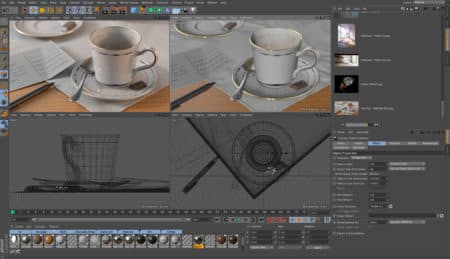Coming one day ahead of the SIGGRAPH 2017 conference, Maxon today announced the latest release of its flagship modeling, rendering, and animation software, Cinema 4D, R19. This next release is more than just an annual update that puts great new tools into the workflows of its users; Cinema 4D R19 offers a glimpse into the future.
Re-Engineered Foundations
With this release, Maxon is introducing re-engineered foundational technologies that will serve the future of Cinema 4D going forward. This new work on foundational aspects of the core code base is just the beginning phases, and Maxon will continue to develop and bring to maturity in the future.
These new core foundational technologies include a brand new modeling core, deeply-integrated GPU rendering for both Windows and Mac, and new OpenGL capabilities in BodyPaint 3D, the company’s professional paint and texturing toolset.

01 – Maxon has announced Cinema 4D Release 19, the latest version of its flagship modeling, rendering, and animation software for professional 3D markets.
“For more than two decades Maxon has been dedicated to delivering 3D graphics solutions with rock-solid stability, outstanding ease-of-use, a fast workflow, and cross-platform capability,” says Harald Egel, managing partner at Maxon Computer GmbH. “Cinema 4D Release 19 expands on those core values with outstanding new features and a first look at foundations for our future.”
Major New Features and Improvements
Release 19 offers major new improvements in areas such as viewport performance, a new Sound Effector, integration of AMD’s ProRender technology, and developments for Voronoi Fracturing added to its MoGraph toolset for motion graphics. There is also a Spherical Camera introduced.
Highlights of these new features and improvements include:
- Viewport Improvements — provide artists with added support for screen-space reflections and OpenGL depth-of-field in addition to the screen-space ambient occlusion and tessellation features (added in R18). Results are so close to final render that client previews can be output using the new native MP4 video support.
- MoGraph Enhancements — expand on Cinema 4D’s state of the art toolset for motion graphics with faster results and added workflow capabilities in Voronoi Fracturing – break objects progressively, add displaced noise details for improved realism or glue multiple fracture pieces together more quickly for complex shape creation. An all-new Sound Effector in R19 allows artists to create audio-reactive animations based on multiple frequencies from a single sound file.
- New Spherical Camera — allows artists to render stereoscopic 360° virtual reality videos and dome projections. Artists can specify a latitude and longitude range, and render in equirectangular, cubic string, cubic cross or 3×2 cubic format. The new spherical camera also includes stereo rendering with pole smoothing to minimize distortion.
- New Polygon Reduction — works as a generator, so it’s easy to reduce entire hierarchies. The reduction is pre-calculated, so adjusting the reduction strength or desired vertex count is extremely fast. The new Polygon Reduction preserves vertex maps, selection tags, and UV coordinates, ensuring textures continue to map properly and providing control over areas where polygon detail is preserved.
- Level of Detail (LOD) Object — features a new interface element that lets customers define and manage settings to maximize viewport and render speed, create new types of animations or prepare optimized assets for game workflows. Level of Detail data exports via the FBX 3D file exchange format for use in popular game engines.
- AMD’s Radeon ProRender — technology is now seamlessly integrated into R19 providing artists a cross-platform GPU rendering solution. Though just the first phase of integration, it provides a useful glimpse into the power ProRender will eventually provide as more features, and deeper Cinema 4D integration is added in future releases.
And regarding modernization efforts the following items are core updates in Cinema 4D R19:
- Revamped Media Core — delivers Cinema 4D R19 users with a completely rewritten software core to increase speed and memory efficiency for image, video and audio formats; native support for MP4 video without QuickTime delivers advantages to preview renders, incorporate video as textures or motion track footage for a more robust workflow. Export for production formats, such as OpenEXR and DDS, has also been improved.
- Robust Modeling — a new modeling core with improved support for edges and N-gons can be seen in the Align, and Reverse Normals commands. More modeling tools and generators will directly use this new core in future versions.
BodyPaint 3D has also received major updates, in particular, it now uses OpenGL as part of its painting engine, giving R19 artists new abilities. When artists paint color or add surface details in film, game design and other workflows, a real-time display of reflections, alphas, bump or normal, and even displacement are shown. This visual feedback is invaluable to 3D artists.

02 – This is a screenshot of the new Maxon Cinema 4D Release 19 (R19). Click on it to zoom in. (Image: Maxon Computer. All rights reserved.)
The company also has introduced the first fruits of its efforts to improve its UV editing toolset in Cinema 4D. There are new faster and more efficient options to convert point and polygon selections, grow and shrink UV point selects and more.
Pricing and Availability
Cinema 4D Release 19 (R19) is scheduled to ship in September 2017. It is available for both Mac OS X and Windows computers.
To learn more visit here. www.maxon.net



Reader Comments
Comments for this story are closed